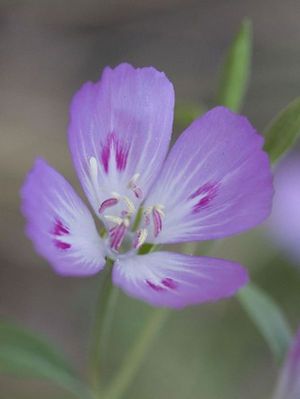Difference between revisions of "Clarkia amoena"
| Line 18: | Line 18: | ||
| synonyms = ''Godetia amoena'' | | synonyms = ''Godetia amoena'' | ||
}} | }} | ||
| − | + | ||
'''Abbreviation code (Codon):''' CLAM | '''Abbreviation code (Codon):''' CLAM | ||
Revision as of 11:17, 21 May 2012
Common name: Farewell-to-spring
| Clarkia amoena | |
|---|---|

| |
| Clarkia amoena | |
| Scientific classification | |
| Kingdom: | Plantae |
| Subkingdom: | Tracheobionta |
| Phylum: | Spermatophyta |
| Subphylum: | Magnoliophyta |
| Class: | Magnoliopsida |
| Subclass: | Rosidae |
| Order: | Myrtales |
| Family: | Onagraceae |
| Genus: | Clarkia Pursh |
| Species: | C. amoena (Lehm.) A. Nelson & J.F. Macbr. |
| Synonyms | |
|
Godetia amoena | |
Abbreviation code (Codon): CLAM
Contents
Description
General: Annual, the stem 1-10 dm. tall, simple or freely-branched.
Leaves: Leaves alternate, sessile, 2-7 cm. long and 2-6 mm. wide.
Flowers: Inflorescence of loose, few-flowered, erect racemes; calyx tube 2-10 mm. long, the 4 lobes united and turned to one side; petals 4, not clawed, 1-4 cm. long, pale pink to rose-purple, with carmine spots in the center, obovate to rounded; style 4-parted, the stigmas 1.5-5 mm. long, yellow, linear to oval; stamens 8, of two lengths, shorter than the style; ovary inferior, 4-celled. Fruit: Capsule 4-celled, 1.5-4.5 cm. long, beakless or with a beak several mm. long, straight or curved, linear.
Bloom Period
June to August
Distribution
West of the Cascades, occasional from Vancouver Island south to California, where more common.
Habitat
Dry, open to wooded areas, at low elevations.
Uses
Indigenous Californians sowed Clarkia species and gathered the seeds to grind for food.
Propagation
Sow seeds after last frost in cold-winter zones. Where winters are milder, sow seeds late summer through fall. Sow seeds in situ in spring or fall in vented containers in a coldframe, indoors before last frost, or direct sow after last frost. Plant plugs grown from seed. Germination is easy and it usually takes less than 90 days from seed to flowering plant. 95% germination occurs within the first two weeks after planting seed in a soil-less peat-based media, amended with micronutrients, slow-release fertilizer, and kept at 70 degree days and 50 degree nights. Prefers nutrient poor, well-drained, sandy loams. Soil should be moist until flowering starts, then it can be quite dry. Seed strains vary in color and habit; some are low and spreading, others tall and erect. Pinch out the central leader to encourage branching and heavy bloom. Do not thin seedlings as crowding encourages blooming. Full or partial sun.
The Seed
Seed Sample from 2010
Features
Measurement average: 1.4 x 1.1 x 0.7
Measurement Range: L: 1.1 – 2, W: 0.75 – 1.1, D: 0.5 – 0.8
Latitudinal Cross Section: irregularly angular Longitudinal Cross Section: irregularly angular
Shape: Seeds angular, somewhat rhombic in shape, but very irregular. Hilum inconspicuous.
Color: Brown
Surface: Seed fuzzy, and appears scaly or pitted where fuzziness is sparse.
Basic Explanations and Assumptions:
The dimensions for the seeds are length x width x depth. The location of the hilum is used as the base of the seed, and the length is measured from hilum to the opposite apex. Where a style is present, the length is measured from the hilum to the bottom of the style. Width is measured at a right angle to the length at the widest part. Depth is measured at a right angle to the intersection of height and width lines.
Measurements included are the mean average for each measurement of ten separate seeds.
All measurements in millimeters unless otherwise noted.




